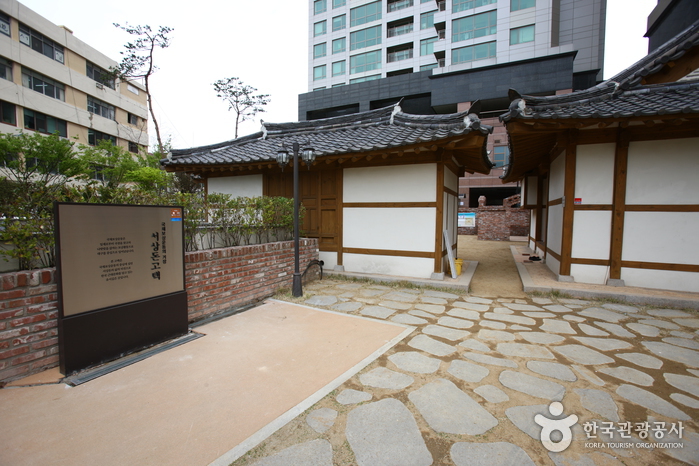ABC-Mart - Daegu Dongseong-ro 2(i)-ga Branch [Tax Refund Shop] (ABC마트 대구동성로2가점)
1.6Km 2024-04-22
40, Dongseong-ro, Jung-gu, Daegu
-
Tonymoly - Dongseong-ro Branch [Tax Refund Shop] (토니모리 동성로)
1.6Km 2024-04-23
124, Singomae-ro, Giheung-gu, Yongin-si, Gyeonggi-do
-
Tonymoly - Dongseong-ro Branch [Tax Refund Shop] (토니모리 동성로)
1.6Km 2024-04-23
93, Bugyuseong-daero, Yuseong-gu, Daejeon
-
Starbucks Daegu Jongro Old House (스타벅스 대구종로고택)
1.6Km 2024-12-27
22 Jungang-daero 77-gil, Jung-gu, Daegu
Special Starbucks store where the past and present meet in harmony
.Starbucks Daegu Jongro Old House store conserved the beautiful architectural style of a hanok house built in 1919 and reinterpreted with the modern touch. The store is composed of two hanok buildings and a garden. There is a separate building for restrooms. Here, you can enjoy the scenery of the four seasons and the history from past to present. The store also offers high-quality audio sound in collaboration with Bang & Olufsen, who was inspired by Daegu, the origin of Korea’s modern music cafe and the city of culture and art. The store sits in the middle of the Jingolmok Alley, the second course of the Modern Cultural Alley Tour, and has become a tourists’ beloved destination and landmark in Daegu. This special store serves as a guide that indirectly delivers a historical meaning.
See Channel Eyewear - Daegu Dongseong-ro Branch [Tax Refund Shop] (씨채널한일로안경 대구동성로)
1.6Km 2024-04-19
604, Gukchaebosang-ro, Jung-gu, Daegu
-
8 Seconds - Dongseong-ro 2(i)-ga Branch [Tax Refund Shop] (에잇세컨즈 동성로2가점)
1.6Km 2024-04-23
34, Dongseong-ro, Jung-gu, Daegu
-
House of Yi Sang-hwa (이상화 고택)
1.6Km 2023-01-06
6-1, Seoseong-ro, Jung-gu, Daegu
+82-53-256-3762
Yi Sang-hwa was a nationalist poet, who resisted the Japanese colonialism. This was his house from 1939 until his death in 1943. His house was neglected after he died, until a citizens' movement in 1999 to preserve the house urged the Military Mutual Aid Association to purchase it, and donate it to the City of Daegu on October 27, 2005. It has been restored and opened to the public, serving as the center for education of the poet's brave spirit and work.
House of Seo Sang-don (서상돈 고택)
1.6Km 2021-07-01
6-1, Seoseong-ro, Jung-gu, Daegu
+82-53-256-3762
The house of entrepreneur and activist Seo Sang-don is located in the heart of Daegu. In 1907, in an effort to repay national debt and to gain independence from Japan, Seo launched the National Debt Repayment Movement as well as a nationwide campaign calling for people to quit smoking.
In celebration of Seo's leadership, the City of Daegu restored Seo's old house and opened it to the public. The City also built the National Debt Repayment Park and erected a statue of Seo in his honor.
Holika Holika - Dongseong-ro Jungang Branch [Tax Refund Shop] (홀리카홀리카 동성로중앙점)
1.6Km 2024-04-23
2F, 31, Dongseong-ro, Jung-gu, Daegu
-
Samsong Bakery main store (삼송빵집 본점)
1.6Km 2024-10-18
397 Jungang-daero, Jung-gu, Daegu
Daegu's representative bakery f(x) KRYSTAL visited
This place opened in 1957 and became famous after a broadcast of KRYSTAL eating bread here, hence it is called Daegu's representative bakery. The best menu is Whole Corn Bun, Squid Ink Whole Corn Bun, Vegetable Croquettes, Streusel Bun with Red Bean Filling, and Cream Cheese Sweet Rice Cake Bread. The high ceilings and chandeliers are impressive. When you go up to the second floor, you will find a minimalist cafe-like atmosphere with simple tables placed in a wide space.
![ABC-Mart - Daegu Dongseong-ro 2(i)-ga Branch [Tax Refund Shop] (ABC마트 대구동성로2가점)](http://tong.visitkorea.or.kr/cms/resource/45/2884045_image2_1.jpg)
![Tonymoly - Dongseong-ro Branch [Tax Refund Shop] (토니모리 동성로)](http://tong.visitkorea.or.kr/cms/resource/30/2884030_image2_1.jpg)

![See Channel Eyewear - Daegu Dongseong-ro Branch [Tax Refund Shop] (씨채널한일로안경 대구동성로)](http://tong.visitkorea.or.kr/cms/resource/54/2884054_image2_1.jpg)
![8 Seconds - Dongseong-ro 2(i)-ga Branch [Tax Refund Shop] (에잇세컨즈 동성로2가점)](http://tong.visitkorea.or.kr/cms/resource/43/2884043_image2_1.jpg)

![Holika Holika - Dongseong-ro Jungang Branch [Tax Refund Shop] (홀리카홀리카 동성로중앙점)](http://tong.visitkorea.or.kr/cms/resource/12/2884012_image2_1.jpg)

 English
English
 한국어
한국어 日本語
日本語 中文(简体)
中文(简体) Deutsch
Deutsch Français
Français Español
Español Русский
Русский